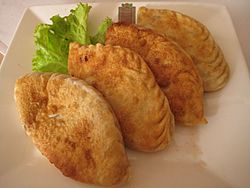Khuushuur facts for kids
 |
|
| Type | Dumpling |
|---|---|
| Place of origin | Mongolia |
| Main ingredients | Dough, meat (beef or mutton), onions or garlic, salt |
Khuushuur (pronounced "hoo-shoor") is a tasty meat pastry or dumpling. It is very popular in Mongolia. You can think of it as a fried pocket filled with delicious meat.
Khuushuur is a bit like other fried dumplings found in Russia and other countries. It is a favorite food for many people in Mongolia.
Contents
What is Khuushuur?
Khuushuur is a type of Mongolian food. It is a flat, half-moon shaped pastry. Inside, it is filled with seasoned meat. People often eat it with their hands.
What is Khuushuur Made Of?
The main ingredients for Khuushuur are dough and meat. The meat is usually beef or mutton. Sometimes, people even use camel meat!
The meat is ground up very finely. Then, it is mixed with onion or garlic. Salt and other spices are added to give it flavor.
How is Khuushuur Made?
First, a cook rolls out the dough into thin circles. Then, a small amount of the seasoned meat mixture is placed in the center of each dough circle.
The dough is folded in half over the meat. This creates a flat, half-circular pocket. The edges of the dough are pressed together firmly. This seals the meat inside. Some Khuushuur can also be made round by pressing the dough and meat together.
After the pockets are ready, they are fried. They cook in hot oil until the dough turns a beautiful golden brown color.
How to Eat Khuushuur
Khuushuur is always served hot. It is a perfect snack or meal. You can easily pick it up and eat it by hand. It's a common dish at festivals and gatherings in Mongolia.
Khuushuur vs. Buuz
Khuushuur is quite similar to another Mongolian dish called buuz. Both dishes use the same kind of meat filling. Both also cook the meat inside a dough pocket.
The main difference is how they are cooked. Khuushuur is deep-fried in oil. Buuz, on the other hand, is cooked by steaming. This makes buuz softer and less crispy than Khuushuur.
See also
 In Spanish: Khuushuur para niños
In Spanish: Khuushuur para niños

